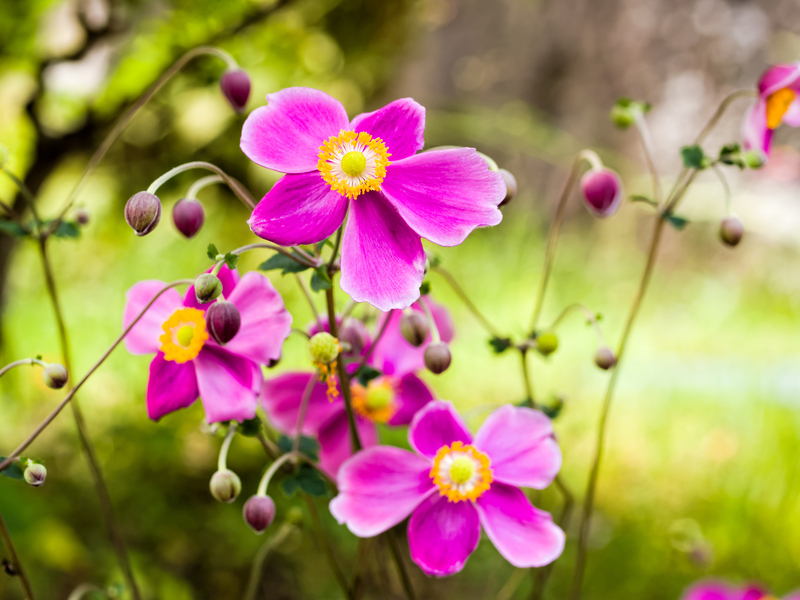Journey into the World of Orchid Care
Posted on 28/08/2025
Journey into the World of Orchid Care: A Comprehensive Guide
Orchids have long mesmerized flower enthusiasts with their exotic beauty and incredible diversity. Yet, beginners often believe these splendid blossoms are difficult to grow and maintain. Let's dispel that myth! In this extensive guide, we embark together on a journey into the world of orchid care, covering essential techniques, tips, and secrets to help your orchids thrive at home.

Understanding Orchid Basics
Orchids belong to the Orchidaceae family--one of the largest and most varied plant groups on earth. With over 25,000 naturally occurring species and more than 100,000 hybrids, orchids can be found on every continent except Antarctica.
The Uniqueness of Orchids
- They possess unique root systems, often adapted for life clinging to trees or rocks.
- Orchid flowers can last several weeks and feature intricate shapes and vivid colors.
- Most orchids are epiphytes, meaning they derive moisture and nutrients from the air rather than soil.
- Popular genera include Phalaenopsis (moth orchids), Cattleya, Dendrobium, and Oncidium.
Starting your orchid care journey is easier when you select the right species for your environment and skill level.
Setting Up for Orchid Success
Choosing Your First Orchid
When stepping into the realm of orchid cultivation, it's wise to begin with a forgiving species such as Phalaenopsis.
- Phalaenopsis (Moth Orchid): Hardy, widely available, and blooms for months.
- Dendrobium: Beautiful and tolerant of a range of conditions.
- Cattleya: Known as the "Queen of Orchids," ideal for those seeking showy blooms.
Buying Healthy Orchids
Inspect for:
- Firm, green leaves (avoid yellowing or spotted foliage)
- Plump, silver-green roots visible through the pot
- No evidence of pests or mold
- Well-established plants over recently divided or tiny seedlings
Tip: Avoid orchids with wilted flowers or mushy leaves to ensure a strong start to your orchid care adventure.
Essential Elements of Orchid Care
1. Mastering Light Requirements
Light is a linchpin of successful orchid growing. Knowing the preferences of your specific orchid is vital:
- Phalaenopsis: Prefers moderate, indirect light. Direct sunlight may scorch leaves.
- Cattleya & Oncidium: Enjoy bright, filtered light.
- Dendrobium: Tolerates higher light levels; some even flourish in nearly full sun.
Place your orchid in an east- or west-facing window for best results. If leaves turn yellow, reduce light; if dark green, increase exposure.
2. Watering Orchids Properly
Overwatering is the leading cause of orchid woes. Here's the secret to proper watering orchids:
- Water only when the potting medium is nearly dry, usually once a week.
- Use room-temperature, non-softened water (rainwater or distilled is excellent).
- Never let roots sit in water. Remove excess water from saucers or decorative pots.
Suitable watering keeps roots plump and supports healthy growth--crucial on your orchid care journey.
3. Humidity and Airflow Needs
Orchid plants crave humidity (about 40-70%) and good air circulation to prevent fungal infections.
- Mist orchids lightly in the morning, especially in dry climates.
- Position pots atop a humidity tray or pebble tray.
- Don't crowd plants; use a gentle fan for circulation.
A balanced environment yields strong, bloom-ready plants!
4. The Right Potting Media and Repotting Orchids
Orchid care guide tips: Unlike most houseplants, orchids will not thrive in standard soil.
- Use specialized orchid potting mix: Common ingredients are bark, sphagnum moss, pumice, charcoal, and coconut husk.
- Repot every 1-2 years--when the media breaks down or roots overtake the pot.
- Choose clear pots to monitor root health and encourage photosynthesis.
Learning to repot is a vital step in every orchid owner's journey.
5. Fertilizing for Abundant Blooms
To maximize blooming and growth, feed orchids with a balanced orchid fertilizer (20-20-20 or similar) diluted to half or quarter strength.
- Fertilize every 2-4 weeks during growth periods (spring and summer).
- Reduce or suspend feeding while the plant is dormant (typically winter).
Orchid Care Challenges and How to Overcome Them
Common Orchid Problems
- Root Rot: Usually from overwatering; check roots regularly, snip off mushy ones, and allow the plant to dry.
- Pests: Watch for scale, spider mites, mealybugs. Treat with horticultural soap or neem oil.
- No Flowering: Review light, humidity, and fertilizer application. Some species require temperature drops to trigger blooms.
- Leaf Problems: Brown tips can indicate low humidity, fertilizer burn, or dehydration.
Being proactive and observant is your secret weapon for thriving orchid care.
Dealing With Bloom Loss
It's natural for orchid flowers to fade after several weeks. Here's how to care for your plant after blooms drop:
- Snip spent flower spikes back to a node (for Phalaenopsis) to encourage more blooms.
- Continue regular care; the orchid will likely rebloom with patience and proper conditions.
The Advanced Orchid Care Adventure
Encouraging Reblooms
Many growers ask: How can I make my orchid flower again? Here's how to succeed on this step of your orchid care journey:
- Ensure 10-15 degree F drop in nighttime temperatures for a few weeks in autumn to spark blooms.
- Give adequate light and slightly reduce watering during this period.
- Fertilize with a "bloom booster" formula once spikes form.
Orchid Propagation and Expanding Your Collection
After mastering basic orchid care, many hobbyists try propagation:
- Division: Most common for mature Cattleyas and Dendrobiums.
- Keiki Growth: "Baby" orchids, often on Phalaenopsis stems, can be potted up once roots are visible.
- Seed Growing: Technically challenging and best left to the advanced grower or labs.
Decorative Tips for Displaying Orchids
Orchids are not just about cultivation--they bring unrivaled elegance to interior design.
- Try grouping orchids of varying heights on an east-facing windowsill.
- Display on tables with indirect sunlight; use stylish cachepots that allow good drainage.
- Attach miniature orchids to pieces of driftwood or cork for a spectacular, naturalistic look.
Seasonal Orchid Care Cheat Sheet
Spring/Summer:
- Peak growth: Increase watering as days lengthen.
- Fertilize according to manufacturer guidelines.
- Ensure maximum light without direct sunburn.
Autumn:
- Reduce watering as growth slows.
- Initiate temperature drop for triggering blooms.
Winter:
- Minimize watering and fertilizer.
- Watch humidity--indoor heating often dries air.
- Supplement natural light with grow lights if needed.
Frequently Asked Questions About Orchid Care
Why are my orchid's leaves wrinkled?
This typically signals dehydration, resulting either from underwatering or root rot--always check root condition before watering more.
How do I cut an orchid flower spike?
For Phalaenopsis orchids, trim above a node to encourage reblooming. Other genera may prefer spikes cut at the base.
Should I mist my orchid?
Misting can increase humidity but avoid excessive moisture on leaves, which can invite disease. Mist in the morning so leaves dry by night.
Is tap water safe for orchids?
Many tap waters contain minerals or chemicals that can build up over time. Rainwater or distilled water is safest for long-term orchid health.

Your Reward: The Beauty of Mastering Orchid Care
With its boundless colors, forms, and fragrances, the orchid plant is one of nature's most splendid teachers in patience and gentle observation. Nurturing orchids connects us with ancient horticultural traditions and invites tranquility into our everyday lives.
Ready to begin your own journey into the world of orchid care? Armed with the insights above, you can confidently select, nurture, and bloom these botanical gems in your home. The path may present challenges, but the reward of thriving, reblooming orchids is worth every careful step. So grab your first orchid, explore the subtleties of its care, and enjoy this exhilarating floral adventure!
Explore More Orchid Inspirations
- American Orchid Society: Orchid Care
- Royal Horticultural Society: Orchid Plant Guides
- Beginner-Friendly Orchid Care from Gardeners Supply
May your journey into the world of orchid care be filled with learning, blossoms, and beauty!



